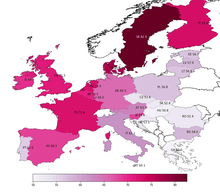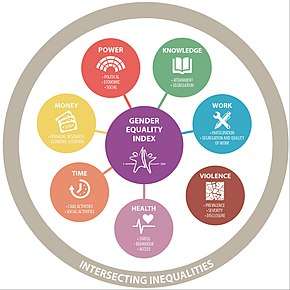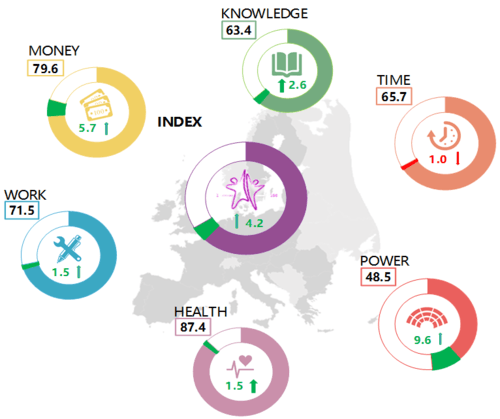Gender Equality Index
The Gender Equality Index is a unique tool that measures how far (or close) the EU and its Member States are from achieving a gender-equal society. The measurement used produces a score that ranges between 1 and 100, where 100 stands for the best situation, where there are no gender gaps combined with the highest level of achievement. It was developed by the European Institute for Gender Equality (EIGE), a full-fledged European Union agency for gender equality.

The Gender Equality Index was published in 2013 and 2015. In October 2017, the third edition was released. The newest one provides scores for four points in time: 2005, 2010, 2012 and 2015.
Purpose of the Gender Equality Index
Gender equality is one of the European Union's founding values, dating back to 1957. The Gender Equality Index aims at supporting evidence-based and better-informed decision-making in the EU. Other statistical indices measuring gender equality also exist, but the Gender Equality Index is the only one that gives a comprehensive map of gender inequalities in the EU and across Member States based on EU policy priorities and realities.
The Gender Equality Index relies on a gender perspective. This means that gender equality is considered to be advantageous to both women and men, while not underplaying the unequal relations of power harming women in society. It also emphasises that all gender gaps are harmful to both women and men.[1]
Areas of gender equality covered

The Gender Equality Index measures gender equality in eight areas, called ‘domains’, relevant to the EU policy framework. Six of these domains (work, money, knowledge, time, power, and health) are combined into a core Index. Each domain is further divided into sub-domains that cover the key issues within the respective area.
The core Index is complemented by two additional, equally important, satellite domains of violence and intersecting inequalities. They belong to the framework of the Gender Equality Index in all respects, but do not impact the overall score. The full conceptual framework is presented in the first edition of the Index.
Using this framework, 31 indicators were chosen to monitor developments in gender equality in the six core domains in every Member State as well as at the EU level. The Gender Equality Index is formed by combining these indicators into a single measure, which allows for the complex issue of gender equality to be synthesised into one easy-to-understand score.
Core domains
| Work
The domain of work compares the position of women and men in the European Union's labour market. It measures gender gaps in participation in the labour market, duration of working life, sectoral segregation patterns and quality of work (such as flexibility of working time and career prospects). |
Money
The domain of money examines inequalities in financial resources and the economic situation of women and men. It measures gaps in earnings and income, as well as the risk of poverty and income distribution. |
Knowledge
The domain of knowledge shows differences between women and men in terms of education and training. This domain measures gaps in participation in tertiary education, segregation in educational fields and lifelo |
| Time
The domain of time measures inequalities in the allocation of time that women and men spend for different activities. It measures gender gaps in the involvement of women and men in caring for their children or grandchildren, older people and people with disabilities, as well as their involvement in cooking and housework in comparison to time spent on social activities. |
Power
The domain of power measures gender equality in decision-making positions across the political, economic and social spheres. The sub-domain of political power examines the representation of women and men in national parliaments, government and regional/local assemblies. The sub-domain of gender-balance in economic decision-making is measured by the proportion of women and men on corporate boards of the largest nationally registered companies listed on stock exchanges and national Central banks. The Gender Equality Index for the first time presents data in the sub-domain of social power, which includes data on decision-making in research-funding organisations, media and sports. |
Health
The domain of health measures gender equality in three health-related aspects: health status, healthy/unhealthy behaviour and access to health services. Health status looks at the differences in life expectancy of women and men together with self-perceived health and healthy life years. This is complemented with a set of health behaviour factors, based on recommendations from the World Health Organisation on healthy behaviour, namely fruit and vegetable consumption, physical activity, smoking and alcohol consumption. Access to health services is measured by the percentage of people who report unmet medical and/or dental needs. |
Satellite domains
| Intersecting Inequalities
Since women and men are not homogeneous groups, this domain looks at other characteristics that may affect gender equality. Five social factors or ‘intersections’ were selected for further investigation: family type, age, country of birth, disability and education. This allows for analysis of the situation of different sub-groups separately as well as gender gaps within these groups. From a policy perspective, it becomes possible to identify which groups of women and men are least/most disadvantaged and to indicate further, better targeted policy measures. |
Violence
The domain of violence provides of a set of indicators that can assist Member States in assessing the extent and nature of violence against women and enable the monitoring and evaluation of the institutional response to this phenomenon. To provide the most complete and reliable picture of violence against women in the EU, a three-tier structure of measurement was defined including: (1) a set of indicators on the extent of violence against women that will form the composite measure; (2) a set of additional indicators covering a broader range of forms of violence against women; (3) a set of contextual factors, which can provide insights on some of the causes and circumstances surrounding violence against women. |
Index main results

The Gender Equality Index is now in its third edition and provides scores for four points in time: 2005, 2010, 2012 and 2015 for the European Union as a whole, as well as individual Member States. This provides readers with sufficient evidence to assess progress over an entire decade. The main results of the third edition of the Gender Equality Index were released in Brussels on 11 October 2017, and were livestreamed on EIGE's website.
Progress towards gender equality in the EU-28 is rather slow – the Gender Equality Index score for EU-28 in 2015 stood at 66.2 out of 100, representing a 4.2-point increase in ten years. The EU and its Member States still have a lot of room for improvement in order to reach gender-equal societies.
The biggest improvement towards gender equality over the past decade has been in the domain of power, especially in economic decision-making. However, while it has made the most progress, its score remains the lowest of all domains. The least amount of progress in gender equality has been in the domain of time. Progress has slipped in 12 countries when it comes to the time use of women and men. Only every third man engages daily in cooking and housework, compared to almost eight in ten women (79%). Men also have more time for sporting, cultural and leisure activities.
The third edition contains important methodological updates. In addition to political and economic power, the Index also looks at who is behind the news headlines, who controls the money in research funding and who decides in the sporting world in the EU. These measurements now form an integral part of the power domain. For the first time, the Index also looks into healthy and risky behaviours of women and men. Who has a healthy diet and exercises regularly? How similar are the smoking and drinking habits of women and men in the EU? The answers to these questions make an impact on the final Index score in the domain of health.
The Gender Equality Index will be updated every two years until 2019. From then on it will be updated annually. This will show how gender equality is evolving over time and space, enabling policy-makers and other stakeholders at EU and national level to use its data to work more efficiently towards making equality between women and men a reality for all Europeans and beyond.
Read more about the Gender Equality Index
European Institute for Gender Equality (EIGE) (2013), Gender Equality Index Report
European Institute for Gender Equality (EIGE) (2017), Gender Equality Index 2017 in brief: A snail’s pace towards gender equality
European Institute for Gender Equality (EIGE) (2017), Gender Equality Index 2017: Main findings
European Institute for Gender Equality (EIGE) (2017), Gender Equality Index 2017: Measuring gender equality in the European Union 2005-2015
European Institute for Gender Equality (EIGE) (2017), Gender Equality Index 2017: Methodological report
European Institute for Gender Equality (EIGE) (2017), Gender Equality Index 2017: Measurement framework of violence against women (to be released in November 2017)
European Institute for Gender Equality (EIGE) (2017), Gender Equality Index 2017: Intersecting inequalities (forthcoming)
All other resources, including the link to watch the conference, are available through the Index’s interactive interface on EIGE's website.
External links
References
- Nancy., Fraser (1997). Justice interruptus : critical reflections on the "postsocialist" condition. New York: Routledge. ISBN 9780415917957. OCLC 35360750.